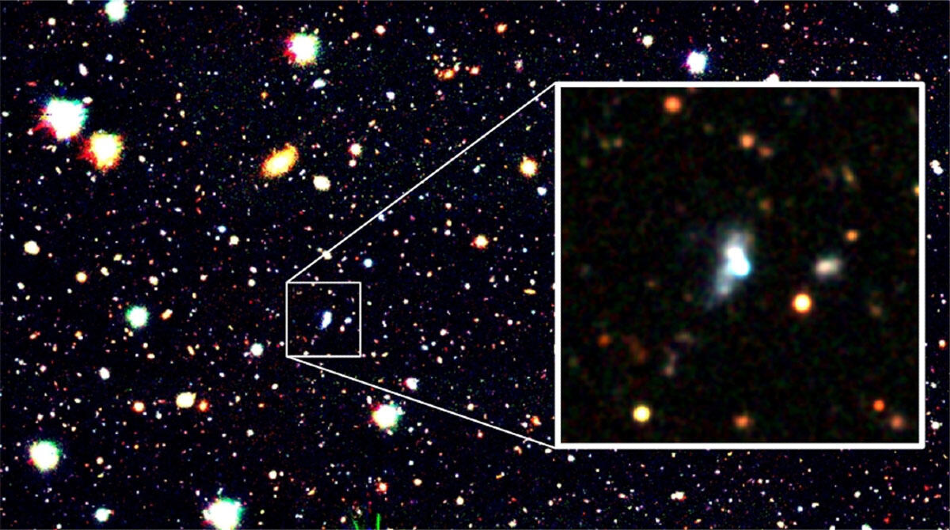Aug 3 2020
Researchers have now discovered a galaxy with a very low oxygen abundance of 1.6% solar abundance, thus breaking the earlier record for the lowest-ever oxygen abundance.
 Image of HSC J1631+4426 discovered by the international team with the Subaru Telescope. HSC J1631+4426 broke the record for the lowest oxygen abundance. Image Credit: NAOJ/Kojima et al.
Image of HSC J1631+4426 discovered by the international team with the Subaru Telescope. HSC J1631+4426 broke the record for the lowest oxygen abundance. Image Credit: NAOJ/Kojima et al.
The team achieved the new results by integrating the power of machine learning with big data captured by the Subaru Telescope. The quantified oxygen abundance indicates that a majority of the stars in this galaxy formed very recently.
Galaxies must be explored in different stages of formation and evolution to gain insights into their evolution. In the modern Universe, a majority of the galaxies are mature ones; however, standard cosmology estimates that there could be certain galaxies still in their early formation stage in the modern Universe.
Since it is rare to spot these early-stage galaxies, an international team of researchers looked for them in wide-field imaging data captured by the Subaru Telescope.
To find the very faint, rare galaxies, deep, wide-field data taken with the Subaru Telescope was indispensable.
Dr Takashi Kojima, Research Team Leader
But it was challenging to spot galaxies in their early stage of formation by using the available data since the wide-field data comprises about 40 million objects. Thus, the researchers created a new machine learning method to spot such galaxies from the enormous amount of data.
The researchers made a computer to repeatedly learn the galaxy colors predicted from theoretical models. Then, the computer was allowed to choose only galaxies in their early stage of formation.
Subsequently, the researchers conducted follow-up observations to identify the elemental abundance ratios of 4 of the 27 galaxies chosen by the computer. Thus, they discovered that one galaxy, named HSC J1631+4426 and situated 430 million light-years away in the Hercules constellation, had an oxygen abundance of only 1.6% of that of the Sun.
This is the lowest value ever observed for a galaxy. The quantified oxygen abundance indicates that a majority of the stars in this galaxy formed more recently. Simply put, this galaxy has been experiencing an early stage of its evolution.
What is surprising is that the stellar mass of the HSC J1631+4426 galaxy is very small, 0.8 million solar masses. This stellar mass is only about 1/100,000 of our Milky Way galaxy, and comparable to the mass of a star cluster in our Milky Way.
Prof. Ouchi, National Astronomical Observatory of Japan and the University of Tokyo
Such a small mass also backs the primordial nature of the HSC J1631+4426 galaxy.
The researchers believe that this discovery offers two intriguing indications. Firstly, it is an evidence of the existence of a galaxy at such an early stage of its evolution st present. As per the context of the standard cosmology, it is regarded that new galaxies are born in the existing universe.
The finding of the HSC J1631+4426 galaxy supports the framework of the standard cosmology. Secondly, a new-born galaxy could be witnessed in the most recent epoch of the cosmic history. The standard cosmology proposes that the universe’s matter density quickly drops with accelerated expansion.
At such a rapid expansion in the future universe, matter will not come together due to gravity, and thus new galaxies will not be born. In the long cosmic history, the HSC J1631+4426 galaxy could be the galaxy of the last generation.
This study will be published in the Astrophysical Journal on August 3rd, 2020 (Kojima et al. 2020, “Extremely Metal-Poor Representatives Explored by the Subaru Survey (EMPRESS). I. A Successful Machine Learning Selection of Metal-Poor Galaxies and the Discovery of a Galaxy with M*<106 Msun and 0.016 Zsun”).
Funding for this study was provided by the Ministry of Education, Culture, Sports, Science and Technology’s World Premier International Research Center Program and Grants-in-Aid for Scientific Research (JP15H02064, JP17H01110, JP17H01114, JP17K14257, JP18J12840, JP18J12727, and JP18K13578).